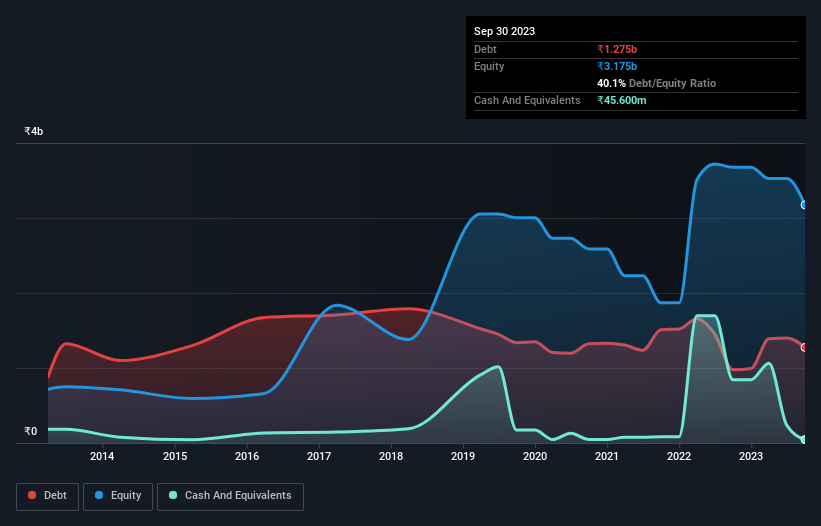Shalimar Paints (NSE:SHALPAINTS) Is Making Moderate Use Of Debt
David Iben put it well when he said, 'Volatility is not a risk we care about. What we care about is avoiding the permanent loss of capital.' When we think about how risky a company is, we always like to look at its use of debt, since debt overload can lead to ruin. We note that Shalimar Paints Limited (NSE:SHALPAINTS) does have debt on its balance sheet. But should shareholders be worried about its use of debt?
When Is Debt Dangerous?
Generally speaking, debt only becomes a real problem when a company can't easily pay it off, either by raising capital or with its own cash flow. Ultimately, if the company can't fulfill its legal obligations to repay debt, shareholders could walk away with nothing. However, a more usual (but still expensive) situation is where a company must dilute shareholders at a cheap share price simply to get debt under control. Of course, debt can be an important tool in businesses, particularly capital heavy businesses. The first step when considering a company's debt levels is to consider its cash and debt together.
View our latest analysis for Shalimar Paints
What Is Shalimar Paints's Debt?
The image below, which you can click on for greater detail, shows that at September 2023 Shalimar Paints had debt of ₹1.27b, up from ₹976.7m in one year. However, it does have ₹45.6m in cash offsetting this, leading to net debt of about ₹1.23b.

A Look At Shalimar Paints' Liabilities
The latest balance sheet data shows that Shalimar Paints had liabilities of ₹2.36b due within a year, and liabilities of ₹179.1m falling due after that. On the other hand, it had cash of ₹45.6m and ₹998.8m worth of receivables due within a year. So its liabilities total ₹1.49b more than the combination of its cash and short-term receivables.
Since publicly traded Shalimar Paints shares are worth a total of ₹17.4b, it seems unlikely that this level of liabilities would be a major threat. But there are sufficient liabilities that we would certainly recommend shareholders continue to monitor the balance sheet, going forward. The balance sheet is clearly the area to focus on when you are analysing debt. But you can't view debt in total isolation; since Shalimar Paints will need earnings to service that debt. So if you're keen to discover more about its earnings, it might be worth checking out this graph of its long term earnings trend.
Over 12 months, Shalimar Paints reported revenue of ₹5.1b, which is a gain of 21%, although it did not report any earnings before interest and tax. With any luck the company will be able to grow its way to profitability.
Caveat Emptor
Despite the top line growth, Shalimar Paints still had an earnings before interest and tax (EBIT) loss over the last year. To be specific the EBIT loss came in at ₹443m. Considering that alongside the liabilities mentioned above does not give us much confidence that company should be using so much debt. So we think its balance sheet is a little strained, though not beyond repair. However, it doesn't help that it burned through ₹267m of cash over the last year. So to be blunt we think it is risky. When analysing debt levels, the balance sheet is the obvious place to start. However, not all investment risk resides within the balance sheet - far from it. For instance, we've identified 4 warning signs for Shalimar Paints (1 doesn't sit too well with us) you should be aware of.
If you're interested in investing in businesses that can grow profits without the burden of debt, then check out this free list of growing businesses that have net cash on the balance sheet.
New: Manage All Your Stock Portfolios in One Place
We've created the ultimate portfolio companion for stock investors, and it's free.
• Connect an unlimited number of Portfolios and see your total in one currency
• Be alerted to new Warning Signs or Risks via email or mobile
• Track the Fair Value of your stocks
Have feedback on this article? Concerned about the content? Get in touch with us directly. Alternatively, email editorial-team (at) simplywallst.com.
This article by Simply Wall St is general in nature. We provide commentary based on historical data and analyst forecasts only using an unbiased methodology and our articles are not intended to be financial advice. It does not constitute a recommendation to buy or sell any stock, and does not take account of your objectives, or your financial situation. We aim to bring you long-term focused analysis driven by fundamental data. Note that our analysis may not factor in the latest price-sensitive company announcements or qualitative material. Simply Wall St has no position in any stocks mentioned.
About NSEI:SHALPAINTS
Shalimar Paints
Engages in the manufacture and sale of paints and coatings in India and internationally.
Mediocre balance sheet with low risk.
Similar Companies
Market Insights
Community Narratives



